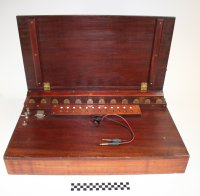The Dark History of the Multiple-Choice Test
Your content has been saved!
Go to My Saved Content.I don’t need to tell you, but the United States is one of the most tested countries in the world, and the weapon of choice is the multiple-choice test. While many scorn them because they don't allow an opportunity for learning, multiple-choice tests have become a staple in the U.S. -- from college admissions to the popular television program Who Wants to be a Millionaire? Multiple-choice questions are an accepted institution. Yet we know little about where they come from. When researching materials for my book, Save Our Science, I stumbled across their not-so-nice origins.
Testing Testing 1-2-3
Most of us have experienced a multiple-choice test. Our children undergo them, you've certainly taken them, your parents probably did, and for some, even their grandparents had to endure them. All of us have given them the power to decide our destiny. But what most of us do not know is that multiple-choice tests resulted from an attempt to legitimize the field of psychology, with a dash of xenophobia and scientific racism. Stephen Jay Gould spells out the dark past of these tests in his aptly titled book The Mismeasure of Man. This highly recommended read reveals all the gory details of IQ testing. Gould explains that the development of IQ testing was used to identify feeble-mindedness in "unwanted" groups (usually determined by race or country of origin1).
Multiple-choice tests had their origin in World War I, when Dr. Robert Yerkes2, President of the American Psychological Association (APA), convinced the Army to commission them to test the intelligence of recruits.3,4 The Army's goal was to improve the efficiency of evaluating men by moving away from time-consuming written and oral examinations. Yerkes' motives were to make psychiatry a more scientific field and move it away from its affiliation with philosophy.
A total of 1.7 million recruits were tested, giving the multiple-choice test an air of legitimacy, but in the end, the Army found no value in the results. Yerkes omitted that part of the story when he sold this idea to educational testing outfits. The validity of the test was not questioned. The rest is an unfortunate history.
Without much of a whimper, the general public accepted these tests, which increased the esteem of the psychological profession and secured its services in education and industry. The multiple-choice test was here to stay. The College Entrance Exam Board's multiple-choice Scholastic Aptitude Test (SAT) became the standard in 1926 -- and there was no going back. By the 1930s, the multiple-choice tests and their offspring, true-false questions, were permanent fixtures in schools.
School testing en masse was perfectly timed with the boon of the growing public school system and the desire to track students. The motives of the system's architects were bankrupt, with an aspiration to create a pecking order among students that resembled the pecking order in society. Players like Lewis Terman, William Shockley and Robert Yerkes are part of science's darker history about fixed intelligence and biases against race and country of origin.1 Yet their legacy lives on today.
A Predicted Result
Multiple-choice tests are not catalysts for learning. They incite the bad habit of teaching to tests and not covering material that will not be evaluated. Ironically, Everett Franklin Lindquist, a creator of standardized tests, was a proponent of not teaching to tests. He wrote that "undue emphasis upon average test results, upon school-to-school and teacher-to-teacher comparisons . . . may cause the teacher . . . to neglect the interests of the pupils, and to be concerned instead with subject matter objectives and with higher average scores for their own sake."5,6
He was absolutely right! Teaching to test became a reality. And his brainchild morphed into the Frankenstein of our nation -- the No Child Left Behind (NCLB) Act of 2001. The tests were supposed to serve us; now we serve the tests.
For many teachers and instructors, multiple-choice testing precludes meaningful teaching. These tests were never designed to improve pedagogy. And, with such inauspicious beginnings, perhaps we should consider if this is a path we want to continue taking. Think about it. There won't be a test.
References
1Gould, S. J. The Mismeasure of Man. (W. W. Norton, 1981).
2Trewin, S. A. "History of Psychology: Robert Yerkes' Multiple-Choice Apparatus, 1913-1939." The American Journal of Psychology 120, 645-660 (2007).
3Kuklick, H. "Book Review: The Testing Movement and Its Founders." Science 237, 1358-1359 (11 September 1987).
4Sokal, M. M. Psychological Testing and American Society, 1890-1930. (Rutgers University Press, 1990).
5Scates, D. E. Chapter IV: The Improvement of Classroom Testing. Review of Educational Research 8, 523 (1938).
6Lindquist, E. "Changing Values in Educational Measurement." Educational Record 17, 64-81 (October 1936).
